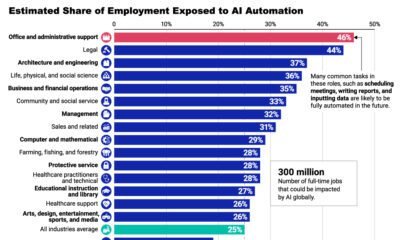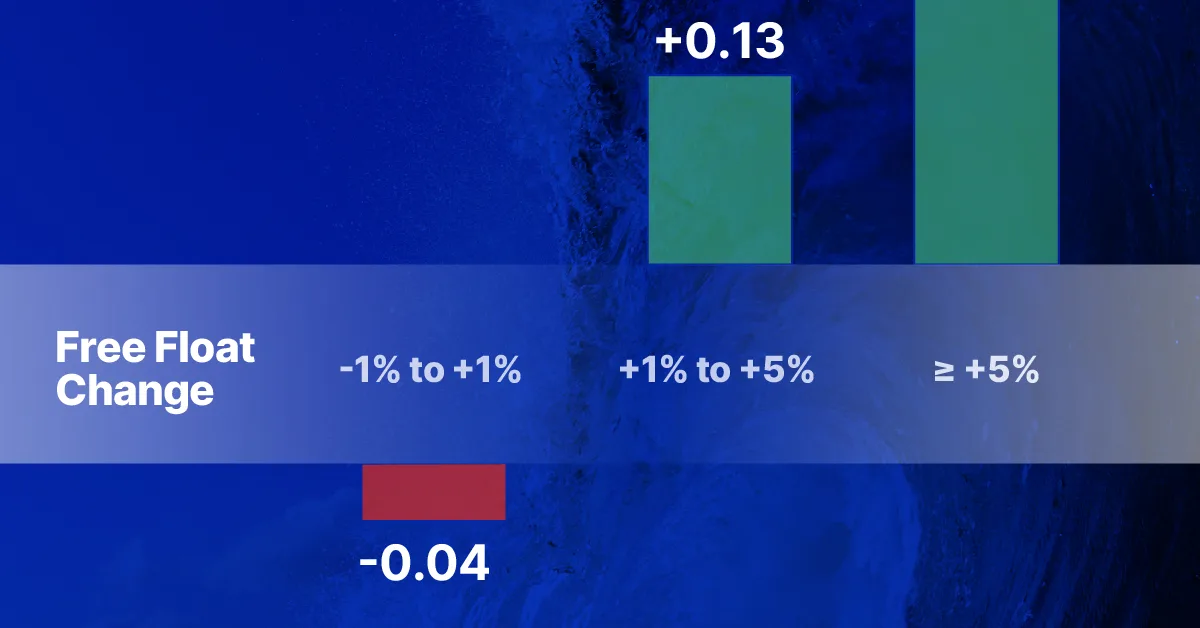When Float Rises, Stock Prices Often Follow
Key Takeaways
- When companies increase their free float, stock-specific returns tend to rise the following month.
- When free float decreases, stock prices often fall.
Stock prices are influenced by a wide range of factors, but one driver may be lesser-known: free float.
This graphic, in partnership with MSCI, shows how changes in free float have historically impacted the next month’s returns.
What is Free Float?
Free float refers to the portion of a company’s shares that are publicly available for trading. It does not include restricted shares held by insiders, which are not typically traded on the open market.
The Float Effect on Stock Prices
MSCI’s analysis found that, historically, stock-specific returns tended to rise the month after an increase in free float. Stock-specific returns are net of market, industry, and style-factor influences.
Conversely, stock prices often dropped after a decrease in float.
| Free Float Change | Average Stock-Specific Returns (%), Month After Free Float Change |
|---|---|
| ≤ -5% | -0.39 |
| -1% to -5% | +0.07 |
| -1% to +1% | -0.04 |
| +1% to 5% | +0.13 |
| ≥ 5% | +0.66 |
Source: MSCI. Data from Feb. 2023 to Sep. 2025. Stock-specific returns correspond to the next month of float-change disclosure and are based on the MSCI global equity risk model (EFMGEMLT).
The scale of the float change mattered, with larger increases in float being associated with stronger next-month performance.
Why might stock prices go up when float increases? When there are more shares available for trading, it can make it easier to buy and sell the stock and attract more investors. On top of this, it may even boost the stock’s weight in major indexes during updates.
Investors may react early to these expected changes, driving up the price shortly after the float increase is announced.
On the other hand, when float decreases, the stock can become harder to trade and might lose ground in index weightings, leading some investors to pull back.
Takeaways for Investors
Free float is more than just a technical index adjustment. Asset owners and money managers can treat it as a risk and return variable, incorporating float changes into trading models and portfolio construction.

Explore key insights on how free float can shape liquidity, risk, and returns.
-

 Investor Education2 months ago
Investor Education2 months agoTwo Markets, Two Stories: How Value Stocks Have Outperformed Internationally
Value stocks outside the U.S. have outperformed their benchmark, making them a key consideration for international portfolios.
-

 Investor Education3 months ago
Investor Education3 months agoWhich Countries Are Winning the Resilience Race?
Discover which economies lead in climate resilience firms—and how investors can spot opportunities in this growing market.
-

 Investor Education4 months ago
Investor Education4 months agoChina’s Economy vs. Market Cap: A Global Imbalance
China’s economy is a large percentage of global GDP, but the country has a small weight in equity markets—here’s what investors need to know.
-

 Investor Education5 months ago
Investor Education5 months agoA New Framework for Personalized Financial Portfolio Alignment
The MSCI Similarity Score compares a client’s financial portfolio to a model portfolio based on risk exposures, allowing for personalization.
-

 Green6 months ago
Green6 months agoTracking Emissions: Corporate Concentration and Climate Progress
Just 1% of companies are responsible for the majority of public company emissions. See the progress companies are making to reduce emissions.
-

 Technology10 months ago
Technology10 months ago3 Reasons Millennials Are Driving the AI Revolution
Millennials are more likely to accept AI than older generations. What other factors could help them drive the AI revolution?
-

 Technology12 months ago
Technology12 months agoThe Fintech Frontier: How Digital Wallets Are Changing Payments
Digital wallets have become the top payment method thanks to their convenience. How can investors track innovation in fintech companies?
-

 Healthcare1 year ago
Healthcare1 year agoCharted: Deaths Related to Bacterial Infection vs. Research Efforts
Globally, nearly 14% of deaths are related to a bacterial infection—but research isn’t keeping up with the need for new treatments.
-

 Healthcare1 year ago
Healthcare1 year agoVisualizing the Rise of Antibiotic Resistance
Antibiotic resistance has nearly tripled in the last two decades, meaning treatments may no longer work for some bacterial infections.
-

 Technology2 years ago
Technology2 years agoCharting the Next Generation of Internet
In this graphic, Visual Capitalist has partnered with MSCI to explore the potential of satellite internet as the next generation of internet innovation.
-

 Investor Education2 years ago
Investor Education2 years agoHow MSCI Builds Thematic Indexes: A Step-by-Step Guide
From developing an index objective to choosing relevant stocks, this graphic breaks down how MSCI builds thematic indexes using examples.
-

 Markets2 years ago
Markets2 years agoWeathering Physical Climate Risks: A Guide for Financial Professionals
Physical hazards like fires pose climate risks for companies, due to the added costs of asset damage and business interruption.
-

 Green2 years ago
Green2 years agoVisualized: What Are the Climate Risks in a Portfolio?
This infographic shows the effects of climate change on investments, and how climate risks may affect a portfolio’s value.
-

 Green2 years ago
Green2 years agoVisualized: An Investor’s Carbon Footprint, by Sector
Which sectors are the largest contributors to emissions? From energy to tech, this graphic shows carbon emissions by sector in 2023.
-

 Investor Education2 years ago
Investor Education2 years agoWhich Climate Metrics Suit Your Investment Goals Best?
When selecting climate metrics, it is important to consider your purpose, the applicability and acceptability of the climate strategy, and the availability of historical data.
-

 Healthcare2 years ago
Healthcare2 years agoInnovation in Virology: Vaccines and Antivirals
Vaccine development has grown six-fold since 1995. Learn how virology, the study of viruses, is driving innovation in the healthcare industry.
-

 Misc2 years ago
Misc2 years agoInfographic: Investment Opportunities in Biotech
Capture the investment opportunities in biotech with the MSCI Life Sciences Indexes, which target areas like virology and oncology.
-

 Technology2 years ago
Technology2 years agoIndustrial Automation: Who Leads the Robot Race?
This graphic from MSCI shows the pace of industrial automation across leading countries like China and the U.S.
-

 Technology2 years ago
Technology2 years agoRanking Industries by Their Potential for AI Automation
AI automation is expected to impact some industries more than others. See the latest projections in this infographic.
-

 Markets3 years ago
Markets3 years agoHow Institutional Investors Can Approach Digital Assets
Digital assets are gaining popularity due to their return potential and decentralized nature. How can institutional investors get exposure?
-

 Technology3 years ago
Technology3 years agoClassifying Digital Assets With a New Framework: Datonomy
How can investors get clarity on the thousands of digital assets available? A new structure classifies digital assets by their use cases.
















